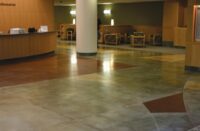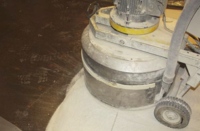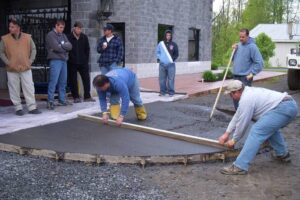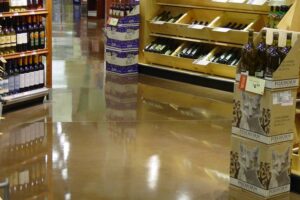
The customer walking the concrete floor at the big-box retail store thinks a concrete floor is hard. So does the worker driving the forklift across the concrete floor of the warehouse. But concrete contractors know that concrete is soft: subject to abrasion, wear, efflorescence, dusting and dulling. That is why contractors and experts who know concrete recommend using a densifier for any floor that will be subject to heavy traffic, wear or abrasion.
Densifiers are typically solutions of silicates that react with any calcium hydroxide that was not bound during the hydration of a concrete slab. Sometimes called liquid hardeners, they impregnate the surface of a cured concrete slab with silica, the basic element of quartz. They essentially complete the hydration process by turning this material into calcium silicate hydrate (CSH), strengthening the concrete matrix.
A densifier offers several advantages, according to Clif Rawlings, product manager and training coordinator for HTC Professional Floor Systems. First, it delivers a denser, harder surface for polishing, heightening the resulting shine, particularly in softer concrete. Second, it blocks efflorescence caused by moisture coming from below the slab. Densified concrete is breathable, but the altered pore structure stops the passage of minerals that cause efflorescence on the surface. Third, it increases abrasion resistance, which increases the longevity of the shine. “We did an informal test in our own warehouse, grinding and polishing one area without densifying it,” Rawlings says. “You can see that the densified area holds up better to forklift traffic.”
Densifiers deliver similar benefits for troweled and broom-finished floors. “The first area that shows wear on broom-finished concrete is the top surface, the peaks,” says Scott Thome, director of product services for L.M. Scofield Co. “Liquid hardeners will toughen up the broom texture so it will last longer.”
Lithium silicates and colloidal silica
Densifiers based on sodium silicates and potassium silicates have been in use for many years. More recently, lithium-silicate densifiers have been gaining popularity. The latest densifier to be introduced is colloidal silica.

Clif Rawlings works with all types of densifiers. Contractors he trains tell him that they use sodium silicates when they are doing a basic ground and polished floor with no color. They use it early in the grinding process, between 80 grit and 150 grit. Sodium silicates, with their larger molecule size, fill larger pores more easily, using less product and keeping costs low.
Older types of densifiers react more slowly, so they must be broomed to break the liquid’s surface tension and keep the material penetrating until it begins to react. Excess densifier must be extracted before it crystallizes into a white, streaky surface. Once that hardens, it can only be removed by grinding.
Lithium silicate densifiers offer some advantages over these older sodium and potassium silicate materials. One is faster reaction time, so constant brooming is not required. “Contractors are able to save time – they don’t have to wait overnight to begin the next polishing step,” says Shane Vest, director of sales and marketing for Convergent Concrete Technologies, whose Pentra-Sil (NL) is widely sold in the industry under private-label agreements.
A lithium silicate is more reactive than a sodium or potassium silicate, Thome explains. “The results are seen earlier.”
Shane Vest says another advantage is that lithium densifiers are not water-soluble. “Once the reaction has taken place in concrete, the lithium will not reabsorb moisture,” he says. “Older sodium and potassium silicates will re-emulsify, allowing moisture in and out of concrete, contributing to crazing.” Bob Harris, president of The Decorative Concrete Institute, explains how this happens. “Sodium in the presence of moisture can sometimes become expansive and contribute to random microcracking.” (The Decorative Concrete Institute sells a lithium densifier under its own name.)
Differences between lithium ions and sodium or potassium ions may contribute to differences in performance. Vest maintains that lithium ions penetrate more deeply and migrate through the concrete matrix more consistently for a more uniform surface.
What’s more, lithium silicates designed specifically for concrete (rather than adapted from other applications such as cosmetics) contain chemistry that improves reaction speed and depth of penetration. One example is Scofield Formula One Lithium Densifier MP, developed in-house by L.M. Scofield chemists. “Penetration and reactivity are two main factors that must be engineered into the product development process,” says L.M. Scofield director of marketing Cam Villar.

Colloidal silica
A colloidal silica densifier is a refined product of sodium silicate. It is a concentrated dispersion of amorphous, nano-sized silica particles in water. The low viscosity of this product allows for rapid surface penetration, and the irregular variations in surface area make rapid bonding with calcium hydroxide in the concrete possible.
The process of applying a colloidal silica densifier is very simple, according to Brad Sleeper, general manager of Lythic Solutions Inc. “You put the Lythic densifier in a pump sprayer and apply in an even spray across the slab,” he says. “After the initial application, apply product over any area that appears dry for 15 minutes. Then you let it dry completely and you’re ready to go.” Excess material dries to a noncrystalline powder that can be swept up with a broom. The Lythic material is shipped as concentrate and reconstituted at a ratio of 4 parts water to 1 part concentrate. Five gallons of concentrate (25 gallons rehydrated) will treat about 10,000 square feet of concrete.
Some applicators report achieving a higher gloss at a lower grit when using a colloidal silica densifer. Others, looking to finish their surfaces to a soft sheen rather than a high gloss, have applied the material to a hard-troweled surface at the time of placement. After a 28-day cure, the slab is cleaned and densifier is applied for a second time and burnished.
Using color with densifiers
Stains and dyes may be applied before or after the densifier. There are good reasons to apply many colorants first. “You want the coloring product to absorb as deeply as possible,” Thome explains. “If you apply a waterborne liquid hardener before you apply the colorant, the surface is filled with water, which prevents absorption of the color.”
Shane Vest agrees. “The best thing to do is to treat the slab with the stain or dye first when the slab is porous to ensure it takes the stain well,” he says. “You would then densify the slab to make it less porous and lock in the color. Lithium densifiers will deepen the color. Neutralizing the floor after coloring and before using the densifier is a must.”
On the other hand, a lithium densifier applied first can improve the look of an acid stain. The lithium hydroxide in the silicate will neutralize the acid in the stain more quickly, so the color will develop faster and be more consistent, Villar says.
The wild card is the fact that no single load of concrete is the same, says Bob Harris. “Each slab needs to be evaluated to prescribe the proper formula. I have seen slabs that have been brought up to 200 grit, then the dye was added and the concrete densified, and mysteriously, the color was completely lost.” Apparently the concrete was so permeable that when the water-soluble dye met the waterborne densifier on the surface, it was carried deep into the concrete.
So soft concrete may require densifying earlier, after being ground with 80 grit metal bond diamond. The floor should be polished up to between 200 and 400 grit before adding color.
Whether color is applied before or after the densifier, polished floors using lithium silicate typically have greater clarity and depth, Thome says.
www.convergentconcrete.com
www.decorativeconcreteinstitute.com
www.lythic.net
www.scofield.com















